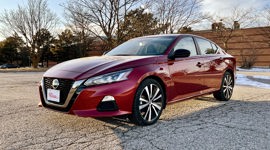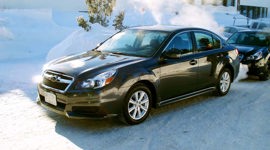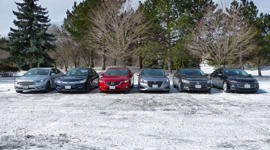 AutoTrader SCORE
AutoTrader SCORE
-
STYLING6/10
-
Safety7/10
-
PRACTICALITY7/10
-
USER-FRIENDLINESS8/10
-
FEATURES8/10
-
POWER8/10
-
COMFORT8/10
-
DRIVING FEEL8/10
-
FUEL ECONOMY6/10
-
VALUE8/10
As I was driving my V6-powered Volkswagen Passat tester one day – might’ve been a Wednesday, not sure – a strange thought came over me.
Even though I grew up driving Passats, I was genuinely surprised by just how classy everything felt inside my tester.
I’m a big fan of car chase movies. I’m talking die-hard: a movie doesn’t have to be considered a “good one” by critics or even moviegoers for me to enjoy it, as long as there happens to be a good car chase in there. I like pretty much every single entry in the Fast and Furious franchise, for example (the second one is the main exception; its car chase isn’t that great and the rest of it, well, is pretty piss-poor). The newer Gone in Sixty Seconds – yeah, the Nic Cage one – wasn’t that well-received by critics, but it may be one of my favourite movies of all time. The shots of Cage’s feet dancing on Eleanor’s pedals and punching her shift lever as he prepares to jump over a multi-car pile-up is something I’ll watch over, and over, and over again.
Then there’s Ronin. Now here’s a movie that got average reviews upon release, and continues to get by with a somewhat lukewarm 68 percent from critics on Rotten Tomatoes. It had a pretty eclectic cast with Robert de Niro as the lynchpin, and the allegory it forms of Japanese ninja lore is not bad.
I have to think, though, that its action sequences involving cars added a solid 10 percent – perhaps more – to that score. And it’s not actually because of the cars; there are no supercars here, not even any sports cars. There’s a BMW that’s badged as an M-car (but actually isn’t), an Audi S8 (with nitrous, but still, pretty tame), a W116 S-Class, and a few other rather nondescript Citroëns and Renaults.
It’s about the driving and choreography, which hits a bit of a climax as De Niro’s character pretty much does a 360 instead of a simple left turn in a busy intersection while driving – wait for it – a Peugeot 406, basically the French equivalent of a Chevrolet Malibu or Toyota Camry. It’s no supercar – it’s not even an invisibly sporty Q car, really – but somehow, it made the cut. If it can do that with a wheezy four-cylinder diesel, I thought as I drove the Passat, then why shouldn’t this make a similar cut with deep-chested, 3.6L V6 power? It may be passed off as old (which it is) and as an executive special (also somewhat true), but I wouldn’t be quite so hasty.
First of all, there’s the power I mentioned. In V6 spec, it makes 280 hp and 258 lb-ft of torque, both figures that will get you going to the next board meeting in a properly sprightly manner. Even without turbocharging, peak torque arrives at 2,500 rpm, which in practice, means that you actually have to be a little more careful than you’d otherwise expect with your throttle inputs. When you think about it, those numbers aren’t really standard mid-size sedan numbers; they’re more figures made by sporting variants of mid-sized sedans, such as the Ford Fusion Sport. That car surprised me when I sampled it, and although the Passat falls a little short in its torque and horsepower counts, it’s not something I’d classify as “slow” by any means. You do pay for it at the pump, however; we saw 12.8 L/100 km, which is somewhat higher than the 10.4 L/100 km overall average VW says we should’ve been getting.
Luckily, all three Passat trims – Comfortline, Trendline, and Highline – come with VW’s venerable 1.8L turbo four as standard, and you have to think that most people that are considering a Passat will be going that way: official combined fuel consumption there is 8.7 L/100 km. The dual engine choices allow the Passat to kind of walk the line between a mass-market midsize sedan, and a car with a slightly more luxurious bent; think switching from Chevy to Buick, for example.
If those producers do go the way of the Passat, it likely won’t be because the car’s styling grabs a lot of attention. This here’s a pretty standard three-box affair, and while a few niceties have been added for 2017 – namely LED daytime running lights to all trim levels – this is a car whose styling hasn’t changed all that much in a number of years. Indeed, rumours are swirling around that it will be replaced soon, so the long-in-the-tooth styling is understandable.
It’s not that it’s bad; the grille is surprisingly proud-looking, the headlights with their LED DRLs do look good and the proportions are muscular if not all that exciting. All the more reason it could be used as the perfect getaway car, really.
Inside, the main draw on our specific tester has to be the colouring of the leather. Four interior colour treatments are available (some are locked to a certain exterior colour, however) and ours was the very sexily named Titan Black/Golden Oak with Vienna leather. It’s not just words, either; the materials used really do feel top-notch and befitting of a luxury sedan. Aside from the seating, you’ll find soft-touch materials in most important spots, with aluminum accents here and ash wood inserts there to add just a little more luxury to the proceedings.
Even though I grew up driving Passats, I was genuinely surprised by just how classy everything felt inside my tester.
Felt the same way when I began to explore the tech on offer through Volkswagen’s App-Connect suite, which provides Apple CarPlay and Android Auto compatibility. They’ve done well to ensure that all this works smoothly and seamlessly; attaching my iPhone and activating CarPlay happened without incident and believe me when I tell you that as simple and plug-and-play these services purport to be, some manufacturers still haven’t got it right.
I’ve had issues on other cars ranging from having to pair Bluetooth in order for CarPlay to work (all that should be required is a USB connection) to CarPlay simply not being recognized at all. Not with the Passat, though; plug in, and you’re off to enjoy your tunes through the crisp Fender audio system. That’s one feature I’m fairly certain will hold its appeal.
Comfort-wise, that traditional high-roofed three-box shape helps provide suitable headroom for both front and rear passengers, though you do have slightly less here than you do in either the Honda Accord or Toyota Camry. We’re talking mere millimetres here, though, so I wouldn’t call it a deal-breaker by any means. Especially when you consider the driving position, which is spot-on, though only modifiable eight ways. I say “only” not because I wasn’t able to find the proper position, but simply because the higher trims on other cars in this segment get 10-plus ways of adjusting your seat.
Luckily for Passat owners, the seats are quite good at the outset, lessening the need to tweak them to the nth degree. The driver’s seat on Highline trims, meanwhile, gets memory settings while the front passenger seat is power-adjustable; it’s manual-only on lower trims.
Being a Highline, our car really only had one option package – the driver assistance package, which adds all the things you’d expect it to such as adaptive cruise and lane-keep assist, but also some you might not, such as active park assist.
Now, there are more and more cars receiving this tech these days, but I’ve tested a few with mixed results. Some end too far from a curb, some aren’t so clear in how to activate them and so forth. VW’s offering is fairly straightforward: hit the button marked with a “P” and a steering wheel, the helpful in-cluster TFT display tells you to slow down and once you come up to a spot that’s suitable, the car takes over steering controls, and all you have to worry about is switching gears and modulating the throttle and brake.
We sampled it a few times and each time – both in perpendicular and parallel fashion – we came off without a hitch. It may seem like a gimmicky feature – I know I did, at first – but once I sampled it I really couldn’t help myself going forward. I’m all for the love of driving, hence my fear of the impending autonomous car, but when it comes to parking, the computers can have it.
What I hope to keep out of digitized hands for as long as possible, of course, is the actual act of driving. Luckily, while my tester had all that semi-autonomous stuff I just listed, it is a Volkswagen, and big or small, Volkswagen knows how to build cars that drive well.
We talked about the power – and it is a highlight – but the ride and handling deserve some honourable mention, as well. After all, when you’re chasing baddies through the streets of Nice or Paris, your fancy V6 isn’t really going to do that much for you, right?
The Passat gets a pleasingly responsive chassis that stay true to its quasi-luxury digs over the worst bumps. You’ll get a little more cowl shake than you may expect over smaller, repetitive undulations but the overall feel is one of comfort and precision. The steering is the main standout: it feels almost as well-weighted as the last Golf I sampled, and it manages to disguise its electric assist well enough for a car in this segment.
Would I like to at least have the option for an AWD chassis? Perhaps, but there’s most likely a reason why VW stopped selling Passats with the 4Motion option: people were choosing to spend their money elsewhere.
Which brings us to my final point, and that’s the value proposition the Passat presents. Even fully loaded as our car was, it comes in at under 40 grand before taxes. Skip the active driver aids – a package that’s not hugely robust, and still leaves you with blind spot assist if you skip it – and you’re down to about 37 grand, and that’s with leather, sunroof, fully implemented infotainment, and that gutsy V6. The Ronin crew would be proud, if only because their chosen getaway car would eat less into their overall take.
| Engine Displacement | 3.6L |
|---|---|
| Engine Cylinders | V6 |
| Peak Horsepower | 280 hp @ 6,200 rpm |
| Peak Torque | 258 lb-ft @ 2,500 rpm |
| Fuel Economy | 11.9/8.5/10.4 L/100 km city/hwy/cmb |
| Cargo Space | 436 L |
| Model Tested | 2017 Volkswagen Passat Highline |
| Base Price | $35,745 |
| A/C Tax | $100 |
| Destination Fee | $1,725 |
| Price as Tested | $40,920 |
|
Optional Equipment
$3,350 – 3.6L V6 FSI engine $2,000; Driver assistance package (adaptive cruise control, park assist, park distance control, lane assist) $1,350
|
|














































